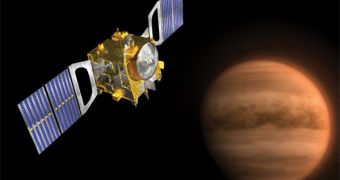The European Space Agency (ESA) has been operating the Venus Express spacecraft around the second planet from the Sun since April 2006. The instruments aboard the probe managed to collect a wealth of data about the surface and atmosphere of the space rock, and contributed considerably to our understanding of its structure. In order to boost the amount of data we have on Venus, experts at ESA conducted a series of 5 aerobreaking maneuvers in its sweltering atmosphere last week, during which the solar panels on the spacecraft were used as sails to propel it through the chemical mix.
This meant that the entire probe was basically transformed into a highly-sensitive sensor, which proved to be very suitable for assessing the density of the atmosphere above Venus, just 111 miles, or 180 kilometers, over the cloud cover that conceals its surface. “The aerodrag campaign went without problem, and conclusively demonstrated that Venus Express can be securely and accurately used to sense the density of the planet's atmosphere. Venus Express has shown once again that it is a very capable satellite,” explained the Venus Express spacecraft operations manager, Octavio Camino.
Measuring atmospheric density with a probe such as this one is fairly easy. All engineers had to do is orient its solar panels in a manner that saw a small amount of torque force being generated in the body of the spacecraft. This happened because the instrument was passing through the faintest traces of the Venusian atmosphere, which created drag. The density could then be inferred from the amount of correction that reaction wheels needed to apply in order to keep the craft in its planned trajectory in space. These wheels counter-rotate within Venus Express itself, and are considered to play a fundamental role in ensuring the success of small correction maneuvers.
According to ESA mission managers, the spacecraft is expected to continue performing such aerobreaking maneuvers well into 2011 and 2012, even though the mission was originally scheduled to end back in May 2009. Due to the amazing performances of the probe, the mission was first extended for 4 months, and then, in September 2009, it was extended to 2010. However, engineers in charge of the machine are convinced that there's still life in it, and that the mission will receive additional funding, Space reports.

 14 DAY TRIAL //
14 DAY TRIAL //